
Edward Winter

CHESS, May 1940, page 193
Vladislav Tkachiev (Moscow) is looking into the history of blitz chess and seeks information (including game-scores) pertaining to a number of rapid-play events, up to and including recent times. He also raises some general questions, such as when ‘blitz’ was first used to describe five-minute chess.
The earliest instance of the term ‘lightning chess’ that we recollect is on page 105 of the March 1897 BCM:
‘What may not unfittingly be called “lightning chess” has been introduced at the Sydenham and Forrest Hills Club. Tournaments are organised on the principle of rapid play, 30 seconds per move being allowed, and half-an-hour for the entire game. Much interest is being evoked by this novel mode of play.’
(2231)
The following two games are bright miniatures played in Spain during the Second World War. In the first Alekhine defeats Pérez in 13th moves and in the second Pérez returns the compliment in 12. The former was a friendly encounter and the latter one of 26 games played by the world champion in an international lightning tournament.
Francisco José Pérez Pérez – Alexander Alekhine
Málaga, December 1941
Vienna Game
1 e4 e5 2 Nc3 Bc5 3 Bc4 d6 4 Nge2 Nc6 5 d4 exd4 6 Nxd4 Nf6 7 Nxc6 bxc6 8 O-O Ng4 9 Qe2 Qh4 10 h3 h5 11 Bf4 Nxf2 12 Bxf7+ Ke7 13 Bh2 Nxh3+ 14 White resigns.
Francisco José Pérez Pérez – Alexander Alekhine
Madrid, 22 October, 1943
Pierce Gambit
1 e4 e5 2 Nc3 Nc6 3 f4 exf4 4 Nf3 g5 5 d4 g4 6 Bc4 gxf3 7 Bxf4 fxg2 8 Bxf7+ Kxf7 9 Qh5+ Kg7 10 Rg1 Nge7 11 Bh6+ Kg8 12 Rxg2+ Resigns.
Source: Agonía de un Genio (Alekhine) by P. Morán, pages 157 and 164.
(CHESS, 1978)
The following game was played at the television studios of DRS (Swiss German Television) during the 1987 Biel tournament. Both prodigies played blindfold and had five minutes for all their moves.
Judit Polgár – Sofia Polgár
Sicilian Defence
1 e4 c5 2 Nf3 Nc6 3 Bb5 g6 4 O-O Bg7 5 c3 Nf6 6 d4 cxd4 7 cxd4 O-O 8 d5 Nb8 9 e5 Ne8 10 Nc3 d6 11 Bf4 a6 12 Bxe8 Rxe8 13 Re1 dxe5 14 Bxe5 Bxe5 15 Nxe5 Bf5 16 Qf3 Nd7 17 Nxf7 Kxf7 18 g4 Nf6 19 gxf5 Rg8 20 Kh1 Qd7 21 Re6 Rad8 22 Rae1 g5 23 Ne4 Qxd5 24 Qc3 and Black lost on time.
This game has not, to our knowledge, been published elsewhere.
(1594)
Jeremy Gaige (Philadelphia, PA, USA) has sent us a copy of the crosstable of the Herceg Novi 1970 (five-minute) tournament, adding:
‘Despite considerable effort, I have not been able to reconstruct it completely.’
Perhaps a reader can help:
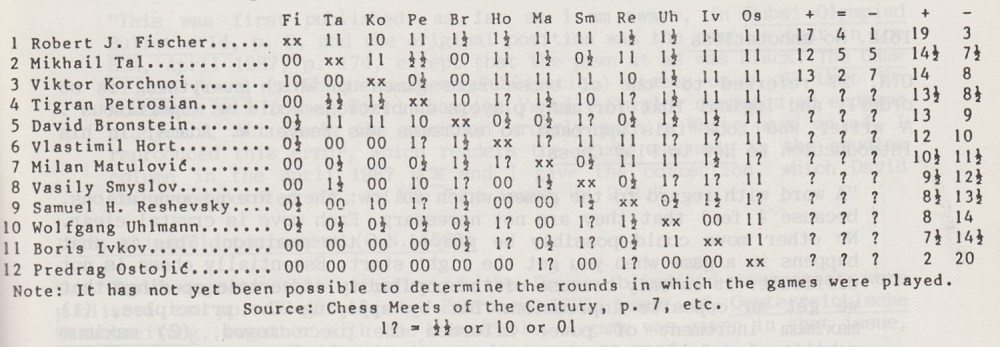
(1609)
From Ludwig Steinkohl (Bad Aibling, Federal Republic of Germany):
‘I have written a book about lightning chess, speed chess, blitz chess, quick play, rapid transit – which are more or less all names for the same activity – without forgetting “active chess”, to use FIDE’s official name for 30-minute games. The book will be published by Manfred Madler, Düsseldorf. As yet it does not have a title.’
Our correspondent would like to know the exact difference between the various English terms listed above. Who would care to venture a few definitions?
Mr Steinkohl continues:
‘I found that Fischer’s games at Herceg Novi were of much higher quality than Kasparov’s games at Brussels in 1986, which was supposed to be the first unofficial lightning world championship. In my view, Herceg Novi has the right to this title. Kasparov’s opponents in Brussels committed many more mistakes than did Fischer’s in Herceg Novi. Not that I join the US House of Representatives in their crazy decision to recognize only Fischer as world champion. But the games played at the two events demonstrate that Herceg Novi was by far the stronger tournament, and I think I know why. Because these days grandmasters play more chess, are more active in many more related fields and are just not able to concentrate as successfully as they did at Herceg Novi.’
(1655)
From Stewart Reuben (Twickenham, England):
‘The names to describe chess played rapidly have indeed become incredibly messy. Herewith some definitions.
Instantaneous chess: meaning each player replies instantly on seeing his opponent’s move. This is impossible to achieve or regularize. All the same, it is often played at congresses which forbid the use of chess clocks for non-tournament games.
Lightning (Britain), Rapids or Rapid Transit (US): meaning each player makes his move ten seconds after his opponent. A bell sounds every ten seconds. The player must move then, not before nor after. This has diminished in popularity now chess clocks are widely available. Draughts used to be played with the bell sounding every five minutes, until they discovered chess clocks provided a superior way of timing the games.
Blitz (Europe), Speed chess (occasional use), Quickplay (Thames TV): A game where each player has five minutes in which to make all his moves. Other lengths of time are common, and it is easy to give sensible odds.
Quickplay (England), Allegro (Scotland), Action (US), Speed (Thames TV), Active (FIDE): these have all been used to refer to games where each player has 30 minutes in which to make all his moves. Actually the Thames TV programmes have been of games where all the moves are played in 25 minutes as they believe this fits better into a 25-minute time-slot – although the game lasts 50 minutes (and is then edited to half that length).
Seeing the problem arising, I sought to popularize “speed” for five-ten-minute chess and “quickplay” for 30-minute games. The latter name has been completely successful in England. Five-minute chess is most likely to be called “blitz” if there is ever to be any uniformity. This has a pejorative meaning for a Londoner born before the Second World War, but I expect to have to give way.
“Active chess” is an appalling name and probably one of the principal reasons the grandmasters have objected to titles being awarded for games played at this rate. An active chess grandmaster sounds more impressive than grandmaster. There would be no confusion with speed chess grandmaster.
Thus I expect five-minute chess to become “blitz” and 30-minute chess “speed”.
Other rates have also been tried, e.g. 30 moves in 30 minutes or 60 in 60. None have had the spectacular success of all the moves in 30 minutes.
I don’t know whether the games in the blitz tournament at Herceg Novi were better than those in Brussels. If so, it is probably because the grandmasters are more active today in serious chess and thus are not so skilled at blitz. It is most unlikely greater activity is leading to poor concentration and thus poorer play.’
Hugh Myers (Davenport, IA, USA) writes:
‘Steinkohl’s guess that GMs don’t play as well at speed chess as did those in 1970 because “they play more chess (and) are more active in many more related fields” is hilariously ridiculous. They don’t play as well in general. Lack of talent (relative) is one factor, and greed is another (score points, beat a few at the bottom, draw with the others). Also, big money Swisses = bad chess.’
(1692)
From page 117 of Wonders and Curiosities of Chess by Irving Chernev:
‘The fastest tournament players have been Zukertort, Charousek, Janowski, Dake and Capablanca.’
To judge by page 34 of the December 1941 CHESS, a likely addition would be F. Apscheneek (or Apšenieks):
‘He was a remarkably fast players, against whatever class of opposition. In the second round of the first Kemeri tournament, he consumed only about 15 minutes over his entire game against Alekhine; the latter took over two hours, the game being drawn in 33 moves.’
Documentation is requested regarding the above players or others.
(1728)
K. Ozols (Thomastown, Australia), a participant in the Kemeri, 1937 tournament, informs us:
‘Fritz Apšenieks was a brilliant chess tactician. He played very fast, but in complicated positions was always able to find the right move. I could not confirm or deny the story concerning his game in Kemeri with Alekhine.
It is interesting that as Alekhine, during the Kemeri tournament, was preparing for his rematch with Max Euwe, he abstained from all alcoholic drink, unlike Apšenieks, who dearly loved a glass of beer or vodka.’
(1760)
An addition could be Abraham Kupchik, about whom Capablanca wrote on page 7 of Diario de la Marina of 16 March 33:
‘It is obvious that young Kupchik does not play as is proper, reflecting upon his moves as would the top player in the world; playing with great rapidity, he tries to win against an opponent who is as strong as him, if not stronger. I can say that I am considered the fastest player in the world amongst the masters, and I can state that the young Russian cannot see very much playing as he does; inevitably his play is superficial and the element of luck counts a great deal in determining the result of his games. I believe that, given his age, the young Russian plays very well, but if he is ever to become somebody, it will be necessary for him to think much more when ... he is playing a match and not just offhand games to pass the time.’
Nigel Freeman (Hong Kong) mentions Viswanathan Anand, quoting a) an interview which appeared in the 2/1988 New in Chess and b) page 99 of the July 1987 CHESS, which reported that Anand took only 16 minutes to beat de Firmian and 25 to defeat Mestel.
(1761)
Regarding Apscheneek/Apšenieks, see also C.N. 3748.
From W.D. Rubinstein (Aberystwyth, Wales):
‘Did you ever get to the bottom of Capablanca’s 5-0 victory in a tournament in New York in 1913 (see Gaige’s Crosstables 1911-20, pages i and 425)? It seems well-nigh unbelievable that Capablanca could have played and won a tournament in New York which has remained unknown. Finding the games would obviously be a great coup.’
Professor Rubinstein is referring to an all-play-all tournament, the crosstable of which was given on page 351 of the 1913 Deutsche Schachzeitung, in which the Cuban achieved a clean sweep against Marshall, Kupchik, Důras, Ettlinger and Adair. Gaige’s Chess Tournaments – A Checklist (page 38) lists it as a rapid-transit event; this is almost certainly correct, but we cannot find any reference to it in the American Chess Bulletin, even though the Bulletin gave accounts of other quick-play events of lower status.
The rough time of the tournament can be deduced from the fact that Důras arrived in the United States on 16 July 1913 (American Chess Bulletin, August 1913, page 174) and Capablanca sailed for Europe on 2 October (Bulletin, November 1913, page 250). The latter was also away from New York (visit to Cuba) between 23 August (Bulletin, September 1913, page 209 and 23 September (Bulletin, October 1913, page 219).
(1796)
From Ken Whyld (Caistor, England):
‘The crosstable of the New York, 1913 lightning tournament was also given in Prokop’s book Československo ve světovém šachu (1935), page 250, where the date is given as September.’
(1834)
From Nine Chess Positions:

White to move
Lehmann-P. Krüger, Lightning game, Hamburg, 19 June 1909
1 Ke5 Rf2 2 Rd1 Rf1 3 Rxf1 e3 4 f6 e2 5 Re1 d2 6 f7 dxe1(Q) 7 f8(Q)+ Kb7 8 Qe7+ Kb8 Drawn.
Source: Deutsches Wochenschach, 24 April 1910, pages 154-155 and 1 May 1910, page 162.
From Jan Kalendovský (Brno, Czech Republic) comes a game played in a blitz tournament following the conclusion of the Olympiad:
Boris Kostić – Paul Keres
Stockholm, 1937
Two Knights’ Defence
1 e4 e5 2 Nf3 Nc6 3 d4 exd4 4 Bc4 Nf6 5 O-O d5 6 exd5 Nxd5 7 Ng5 Be7 8 Nxf7 Kxf7 9 Qh5+ g6 10 Bxd5+ Kg7 11 Bh6+ Kf6 12 Qg5 mate.
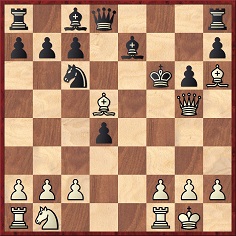
Source: Šachový tyden, 1937, page 119.
(2036)
As noted on page 71 of A Chess Omnibus, the following year (February 1898 issue, page 75), the BCM expressed an uncompromising view:
‘Continuous tournaments, and rapid games of one minute per move, have been lately in great favour in America. They have not yet caught on much in Europe, and we hope the latter kind never will do so, for though they may be very amusing, and may promote a quick sight of the board, they are more of the nature of skittles than of solid and thoughtful chess, and we should think would be a very poor preparation for contests of any real importance.’
The same page of our book also added that the Hereford Times of 22 June 1895 referred to ‘Bird and Burn playing lightning chess’.
See Earliest Occurrences of Chess Terms for an 1873 specimen of the term lightning chess. The game in question, Belden v Gilberg, lasted seven minutes and was given in C.N. 4886. Our ‘Earliest Occurrences’ feature article also cites the first use of the term ‘blitz’ that we have found so far (dating from 1942).
The conclusion of a quick game between Alekhine and Tartakower, played at Carlsbad on 8 May 1923 appeared in C.N. 1050, taken from the Wiener Schachzeitung, July 1923, pages 135-136.

1 Ba7 Kc4! 2 b6 Kc3! 3 b7 d2 4 b8(Q) d1(Q)+ 5 Kg2 Qd5+ 6 Kg3 Kd3!! 7 Qb1+ Ke2 8 Qc2+ Bd2 9 Bc5 Kf1!! 10 h4 Qg2 mate. (Punctuation by Tartakower.)
Richard Forster (Winterthur, Switzerland) writes:
‘The initial position is clearly drawn. White’s 8 Qc2+ isn’t the most accurate, but only 9 Bc5?? loses the game. 9 Qb2 and 9 Kh2 still draw.’
(2152)
The scores of speed games from yesteryear are scarce, but the American Chess Bulletin of April 1918 (page 78) published one between Marshall and Janowsky, played at 20 seconds per move:
Frank James Marshall – Dawid Janowsky
New York, 1918
Queen’s Pawn Game
(1848)
From pages 156-157 of the 10 April 1909 Chess Weekly comes this position in which Charles Curt had the white pieces against Hermann Helms in ‘a rapid transit tournament recently played at the Brooklyn Chess Club’:
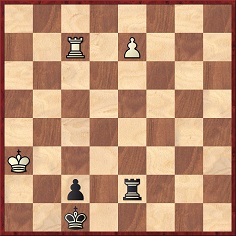
Black to play
The game went 1…Kb1 2 Rb7+ Ka1 3 Rc7 Re3+ 4 Ka4 Kb2 5 Rb7+ Ka2 6 Rc7 Re4+ 7 Ka5 Kb3 8 Rb7+ Ka3 9 Rc7 Re5+ 10 Ka6 Kb3 11 Rb7+ Ka4 12 Rc7 Re6+ 13 Ka7 Rxe7 14 Rxe7 c1(Q) 15 Rb7 Qc5+ 16 Ka8 Qc6 17 Kb8 Ka5 (‘Here the queen should have been played away from the c-file, but even then the ending is difficult to win in ten-second chess.’) 18 Ra7+ and draws. (‘Drawn by perpetual check, because if 18…Kb6 19 Ra6+ and stalemate.’)
No mention was made of Emanuel Lasker’s 1890 endgame study featuring the same motif.
(2717)
A game-score supplied by Eduardo Bauzá Mercére (New York, NY, USA):
Efim Bogoljubow – Horst Leede
New York, 1924 (ten seconds per move)
French Defence
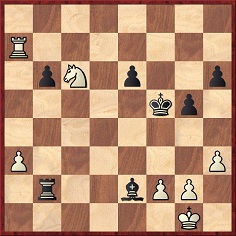
37…Kf6 38 Rh7 h5 39 Rh6+ Kf5 40 f3 Ra2 41 Kh1 Bf1 42 g3 Bg2+ 43 Kg1 Bxf3 44 Nd4+ Ke4 45 Nxe6 Rg2+ 46 Kf1 Rxg3 47 Rg6 Kf5 48 Rh6 Rxh3 49 Kf2 g4 50 Ng7+ Kf4 51 Rf6+ Kg5 52 Rxb6 Rh2+ 53 Kf1 g3 54 Rb5+ Kg6 55 White resigns.
Source: Brooklyn Daily Eagle, 19 June 1924.
(2894)
Familiar examples of speed chess include:
Another game involving Tenner, a win against Field, was given on page 15 of the January 1923 American Chess Bulletin:
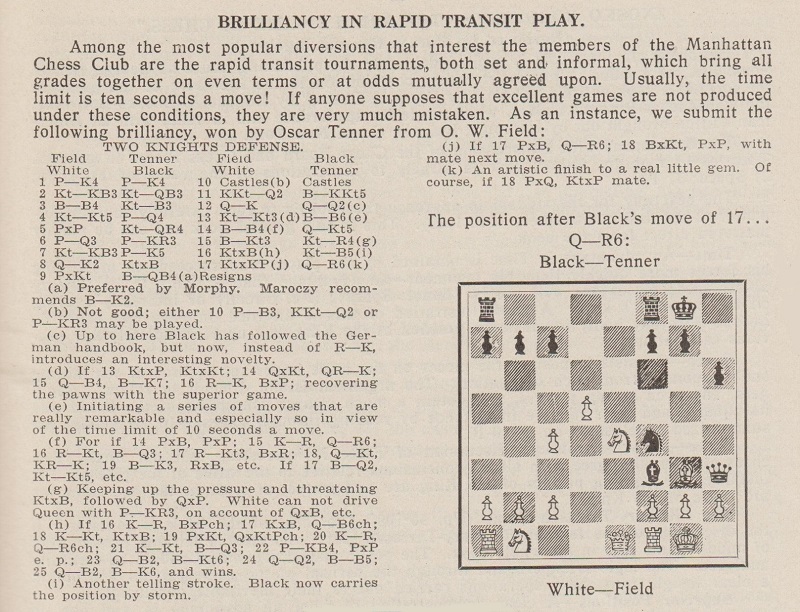
Widely published, it is customarily dated 1923. However, it appeared in the New York Evening Post of 27 December 1922.
C.N. 73 gave a lightning game between Alekhine and Pirc played in Ljubljana in 1930, our source being page 120 of the Times Literary Supplement, 12 February 1931. See also page 386 of the Skinner/Verhoeven volume on Alekhine.
We are grateful to Ed Tassinari (Scarsdale, NY, USA) for information about Capablanca’s involvement with chess at Columbia University. Our correspondent has been through the Spectator, the university’s daily newspaper, from autumn 1906 to spring 1908. To mention just one report, the 11 December 1906 issue related that in a 30-seconds-per-move tournament the previous evening the Cuban finished first in a field of eight, defeating W. Koo, O. Brown and, in the final round, L.J. Wolff.
(2262)
Neil Brennen (Norristown, PA, USA) supplies the game below. Although it ends with a blunder, it is of some historical interest because few of Capablanca’s lightning games have survived.
Abraham Kupchik – José Raúl Capablanca1 e4 c6 2 d4 d5 3 Nc3 dxe4 4 Nxe4 Nf6 5 Nxf6+ exf6 6 Nf3 Bd6 7 Bd3 O-O 8 O-O Nd7 9 c3 Re8 10 Qc2 Nf8 11 Bf5 Qc7 12 Be3 g6 13 Bxc8 Raxc8 14 Rfe1 Nd7 15 Re2 f5 16 Rae1 Nf6 17 Bc1 Rxe2 18 Rxe2 Qa5 19 a3 b5 20 Ne5 c5 21 Qd3 Ne4 22 Bh6 cxd4 23 f3 Bxe5 24 fxe4 dxc3 25 bxc3 Rxc3 26 Qd5 Qb6+ 27 Kf1 Qe6 28 Qd8+ Resigns.
Source: Philadelphia Inquirer, 29 June 1919.
The newspaper records that the time-limit was unusual: ‘five seconds for the first ten moves and ten seconds a move thereafter’. Although it was stated that the game ‘was played recently’ we believe that it was the loss referred to on page 28 of the January 1919 American Chess Bulletin. The tournament, held at the Manhattan Chess Club, was won by Janowsky, with Capablanca and Kupchik equal second. In a rapid transit tournament in October 1918 Janowsky had also finished ahead of the Cuban, whom he beat in their individual game (American Chess Bulletin, December 1918, page 254).
(2457)
In an item reproduced on page 61 of Kings, Commoners and Knaves we gave, courtesy of Jack O’Keefe (Ann Arbor, MI, USA), a ten-seconds-per-move game between M.A. Shapiro and Capablanca played in New York on 11 March 1924. We first published Mr O’Keefe’s discovery on pages 26-27 of the Winter 1990 issue of Kingpin and placed it on-line in C.N. 6535. Previously, only two specimens of rapid transit chess by the Cuban were known (games against Meyer and Rosenthal). See page 100 of The Unknown Capablanca by David Hooper and Dale Brandreth (London, 1975).
Pages 119-121 of Capablanca in the United Kingdom (1911-1920) by V. Fiala (Olomouc, 2006) gave the scores of four lightning games won by Capablanca in Hastings in 1919, against R. Michell, B. Kostić, P. Flowers and E. Jesty.
Capablanca won the first two lightning tournaments held in Hastings (on 9 and 13 August 1919). The third, in which he did not participate, took place on 20 August 1919 and was won by A.G. Condé. Brief reports appeared on pages 285, 287 and 289 respectively of the September 1919 BCM.
The following game was played at ten seconds per move:
William Albert Fairhurst – Edmund Spencer1 e4 e5 2 Nf3 Nc6 3 Bb5 Nf6 4 O-O Nxe4 5 d4 Be7 6 Qe2 Nd6 7 Bxc6 bxc6 8 dxe5 Nb7 9 Nc3 O-O 10 Re1 Nc5 11 Nd4 Re8 12 Nf5 Bf8 13 Qg4 Kh8 14 Bg5 f6 15 exf6 Rxe1+ 16 Rxe1 gxf6
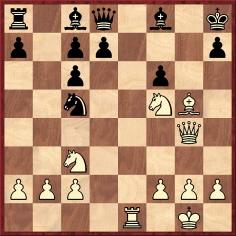
17 Re8 Resigns.
Sources: BCM, September 1924, page 356 and the Chess Amateur, February 1925, page 129.
The game was played in an informal lightning tournament won by Fairhurst, shortly before his 21st birthday. Among the other competitors were Morrison, Rubinstein and Yates.
Half a century later Fairhurst was still going strong, playing top board for New Zealand at the Nice Olympiad.
(2590)
In the game below a move had to be made every ten seconds:
H. Laboschin – N.N.1 e4 e5 2 Nf3 Nc6 3 Bc4 Bc5 4 c3 Nf6 5 d4 exd4 6 cxd4 Bb4+ 7 Nc3 Nxe4 8 O-O Nxc3 9 Re1+ Ne4 10 Rxe4+ Be7 11 d5 Nb8
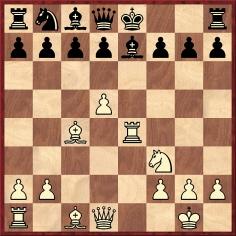
12 d6 cxd6 13 Qxd6 b6 14 Bxf7+ Kxf7 15 Ng5+ Bxg5 16 Bxg5 Qxg5 17 Rf4+ Ke8 18 Re1+ Kd8 19 Rc1 Qg6 20 Rf8+ Rxf8 21 Qxf8+ Qe8 22 Rxc8+ Resigns.
Source: Deutsche Schachzeitung, July 1912, page 209.
(2598)
From an editorial by C.S. Howell on pages 17-18 of the Chess Weekly, 12 December 1908:
‘We admire the modern style of a Lasker who accumulates small advantages and relentlessly squeezes his opponent, but the big majority of us would rather play over the games of Morphy than those of Lasker. We want sacrifices and combinations and brilliancy.
Let’s do something! Let’s rise up in our wrath and make the masters play at the rate of 40 moves an hour, and in our little matches and tournaments let’s play at the rate of 50 moves an hour! Then more of the public will play and the published games will have more sparkle and spontaneity to them. The natural objection to such a plan is that it would result in blunders and a poor quality of chess. At first, perhaps, but under a fast time-limit players would have to use position judgment and that judgment would develop and improve. Trained players generally pick out a good move at sight and waste time only because they have it.
For proof, the reader is referred to the quality, brilliancy and accuracy of Pillsbury’s simultaneous blindfold play, which was conducted generally at a speed well above 50 moves an hour. In London, Dr Lasker, in an exhibition against 20 strong players, averaged over 100 moves an hour and only lost one game. The writer watched the exhibition and did not see the doctor make one real blunder.
And these are cases where the attention was divided among many games. In all seriousness, we should like to see the experiment tried in at least one important tournament.’
(2746)
From Tim Bogan (Chicago, IL, USA):
‘I have come across two claims of chess played at high speed which seem exaggerated to me. Firstly, Alexander Kotov writes on page 32 of The Art of the Middle Game (Harmondsworth, 1964):
“When I stayed behind at school with my school friends after lessons, and managed to play up to a hundred games in a single afternoon...”
If we define “afternoon” generously as noon until 6 p.m. the time-limit would have to be 1.8 minutes, i.e. each player is allowed 108 seconds to make all his moves (6 hours x 60 minutes = 360 minutes / 100 games = 3.6 minutes per game for both players). This leaves no time to set up the pieces, set the clock, etc., but I have seen young players of speed chess complete all their moves within one minute, so it is barely possible.
Reuben Fine, however, takes us to a new level. He writes on page 61 of Chess Marches On! (New York, 1945):
“Naturally, tournament chess requires several hours, sometimes as many as eight or ten, for the completion of a single game; so does baseball, and football, and golf. But chess at lightning speed is also a possibility – experts in offhand moments can finish 50 or 100 games an hour if they are so minded.”
Fifty games in one hour would require a time-limit of 36 seconds for a player for the entire game (60 minutes / 50 games = 1.2 minutes per game for both players). A hundred games in an hour would necessitate a time-limit of 18 seconds for a player to complete all his moves. While it is possible to play such games, it seems certain that each would be prematurely ended by a player exceeding the time-limit in a position where his pieces were hardly developed. They could not be “games” in the commonly understood sense.
Are there other exaggerations of chess speed?’
(3473)
A rapid transit game from the two-volume Schachjahrbuch 1924 by Ludwig Bachmann (see Chess in 1924):
von Seefried – Künzler
Munich, 15 November 1924
Queen’s Gambit Declined
1 d4 d5 2 Nf3 c6 3 c4 Nf6 4 Nc3 Bf5 5 Bg5 Ne4 6 cxd5 cxd5 7 Qb3 Qa5 8 Qxd5 Qxd5 9 Nxd5 Na6 10 e3 e6 11 Bb5 mate.
There cannot be many games which end in such a quick mate after an exchange of queens. For some reason various databases incorrectly give 1927 as the date.
Page 121 of the June 1920 issue of La Stratégie reported that on 20 June Reshevsky had played 14 lightning games (lasting an average of two minutes each) against E. Antoniadi, winning with a score of +12 –1 =1.
(3840)
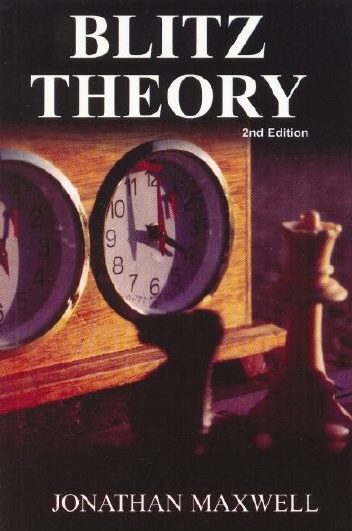
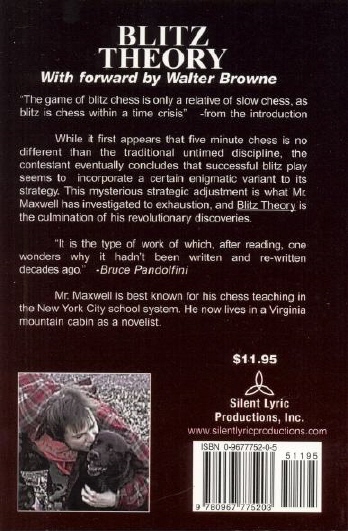
If the only problem with Blitz Theory by Jonathan Maxwell (Flint Hill, 2005) were the typos and shoddy language (enough to have even a Cardoza author looking over his shoulder), the book would not be mentioned here, just as most Cardoza tomes have been passed over in mute dismay. Since, however, the back-cover blurb of Mr Maxwell’s book bills it as ‘the culmination of his revolutionary discoveries’, readers may welcome an inkling of what he has revolutionarily discovered. We therefore pick two examples, the first being on pages 92-93:
‘... when [a piece] is placed with too much inaccuracy, the veteran player is greatly distracted at this “smudge” on the board. By purposely creating such smudges, we can favorably distract our opponent into serious blunders. Let’s look at an example ...
The move Nf5 creates a standard discovered attack on the queen, and will be seen in a typical situation. By placing the knight not directly in the center of the square, but a good ways past the edge of the square, there is a fine chance that the opponent’s flow of concentration will be jostled, and his view of the position will now be skewed in the direction of the “sloppy knight”. Now that he is distracted to the wrong side of the board, there is every likelihood he will miss the attack on his queen, and leave it vulnerable to the naughty bishop.’
On page 96 the revolutionary discoverer offers further counsel which is absent from Chess Fundamentals:
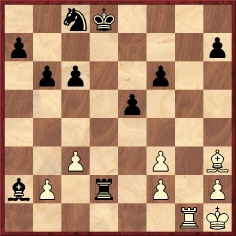
‘When we have an obvious check with a rook or queen, we don’t play the check, but instead say “check” while merely cutting the king by placing the piece on the line adjacent to the check. In the above diagram, our opponent will expect the move to be the Rg8 check. Instead, we say “check” while playing the wily Rg7 blitz tactic! Now there is every chance that upon seeing the typical rook thrust he will move out of the anticipated check, and walk right in to our true check. We can then claim his illegal move as our victory.
This is a perfectly legal tactic. While the unfortunate mark may complain about the validity of the swindle, the fact is that there is no such thing as a “false check call”. Vocal declarations of check have no relevance in blitz or slow chess. Only the board speaks of the king’s danger.’
The back cover sports an appreciative word from Bruce Pandolfini, and the opus has a foreword (‘forward’ three times in Mr Maxwell’s spelling) by Walter Browne. While dissociating himself from ‘the “pseudo check” technique’, Browne writes, ‘Otherwise I endorse this uniquely insightful book with open arms!’
(4311)
A comment by B.H. Wood on page 19 of CHESS, November 1944:
‘Najdorf is a born chess genius and, with a little of the self-discipline which he so strikingly lacks, capable of winning any world championship. At lightning chess he scintillates; we once saw him beat Tartakower (who is quite a doughty exponent of this game himself) 14 times in succession at “five-minute” play. This could not be a normal result, but it illustrates the extraordinary swing of his temperament.’
(4802)
From page 15 of the January 1934 American Chess Bulletin:
‘Having returned home during the Christmas holidays, José R. Capablanca is still in Havana, where, happily, political conditions are returning to normal. Before leaving New York he visited the Marshall Chess Club and, quite informally, took part in one of its weekly rapid transit tournaments. Winning nine games straight, the famous Cuban carried off the first prize. Reuben Fine, club champion who has to his credit a long series of victories in these weekly bouts, scored 7-2 and divided the second, third and fourth prizes with Milton Hanauer and Samuel Reshevsky.’
Gene Gnandt (Houston, TX, USA) sends us the more detailed report on page 31 of the New York Times, 7 December 1933:
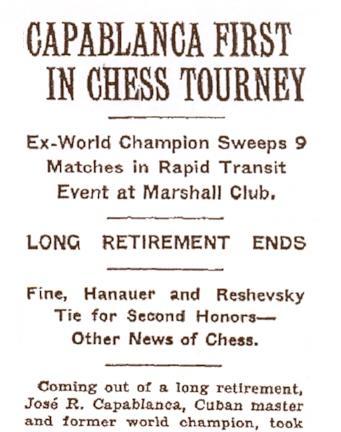
The newspaper gave the complete final standings of the tournament (played on 6 December 1933) as follows: Capablanca 9-0; Fine 7-2, Hanauer 7-2 and Reshevsky 7-2; Chernev 4-5; Hamermesh 4-5; Dunst 2-7, Hammer 2-7 and Simon 2-7; Sack 1-8.
(4817)
For further information on Fine’s exploits, see Reuben Fine by Aidan Woodger (Jefferson, 2004) and Blindfold Chess by Eliot Hearst and John Knott (Jefferson, 2009).
Page 109 of the 1 May 1947 Chess World reported:
‘The Adelaide player F. Villner claims a world’s record: shortest game ever won by a player receiving odds in a tournament. The game was played in a lightning tourney in Sweden, the time-limit being three seconds a move.’
Black, who played without his f-pawn, was not named. The moves were 1 d4 Nc6 2 e4 Nh6 (‘Aiming at f7, a recognized development at these odds, but not after White has played d4.’) 3 Bxh6 gxh6 4 Qh5 mate.
(5362)
C.N. 5412 quoted some remarks by Frederick Karl Esling (1860-1955) on page 152 of the 1 July 1950 issue of Chess World:
‘Anderssen, a professor of mathematics, was a pleasant, amiable man who had won the first international tournament, London, 1851. He was the quickest mover I have seen amongst those using clocks, and at any time-limit over 30 moves an hour would, I believe, have been invincible. He generally finished his match-game early and, having disposed of his score-sheet, set up the pieces and was ready to play anybody, at any odds asked for. He told me that he could place opponents in the four other continents, but thought that I was the first Australian he had met.’
An item from page 385 of Kings, Commoners and Knaves:
‘He was much the fastest tourney player I ever saw. He took little time over his moves, only once did I see him requiring about ten minutes.’
F.K. Esling, Chess World, 1 October 1947, page 225. Esling had won an offhand game against Anderssen as far back as 1878.
Wanted: contemporary substantiation of a remark supposedly made by Lasker to Capablanca:
‘A week or so earlier [compared to 26 July 1914] these two masters had met in Berlin, where they played a rapid-transit match of ten games. Capablanca won 6½:3½, and afterwards Lasker is alleged to have said, “It is remarkable: you make no mistakes”.’
Source: The Unknown Capablanca by David Hooper and Dale Brandreth (London, 1975), page 168.
Irving Chernev gave the words as ‘It is remarkable; you never seem to make a mistake’ in Chess Review, April 1954 (inside front cover and page 125) and as ‘Young man, you play remarkable chess! You never make a mistake!’ on page 234 of Combinations The Heart of Chess (New York, 1960).
(6077)
From page 251 of the June 1908 BCM, in the obituary of H.E. Bird:
‘He claimed to be the chess champion of the world at lightning speed – say, at 1,000 moves per hour.’
Can relevant citations be found in Bird’s writings?
(6536)
Lilienthal never defeated Alekhine in a tournament but was successful against him in blitz play. Since confusion sometimes arises over the matter, we reproduce the account provided by Lilienthal on page 24 of his autobiographical work Életem, a sakk (Budapest, 1985):
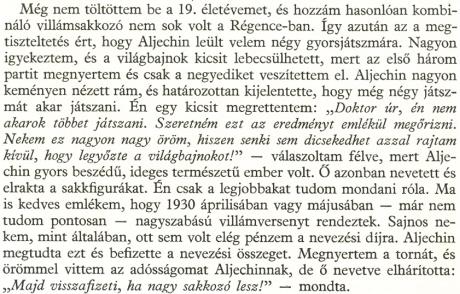
Below is the German translation, from pages 19-20 of Schach war mein Leben (Thun, Frankfurt/Main, 1988):
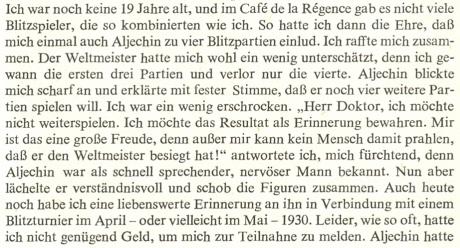

(6570)
Robert Desjarlais (Bronxville, NY, USA) enquires about the origins of Fischer’s reported statement that ‘blitz kills ideas’.
The best citation that we can currently offer is a second-hand one, on page 308 of the June 1970 Chess Life & Review. Dragoslav Andrić wrote: ‘while Fischer is known for his pronounced years-long aversion to blitz play, which, in his opinion, “kills your ideas”.’
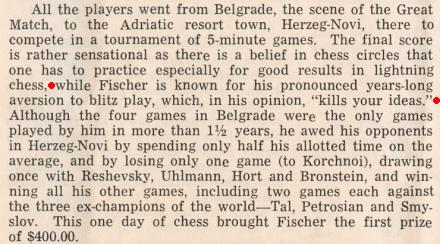
(6595)
When Reuben Fine won the 1944 US Lightning Championship (playing, at ten seconds per move, 22 games in a single day), he dropped only one point, in this game:
Julius Partos – Reuben Fine1 d4 Nf6 2 c4 g6 3 Nc3 Bg7 4 Nf3 O-O 5 e4 d6 6 Bd3 Nbd7 7 O-O e5 8 dxe5 dxe5 9 Bc2 c6 10 Bg5 h6 11 Bh4 Qe7 12 Qe2 Nc5 13 Bg3 Nh5 14 Rad1 Ne6 15 Qd2 Nd4 16 Nxd4 exd4 17 Ne2 Rd8 18 Bd3 Be6 19 f4 Nxg3 20 Nxg3 Bg4 21 Rde1 Bd7 22 e5 Re8 23 Ne4 c5 24 Nd6 Reb8
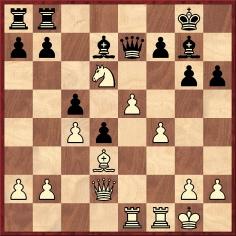
25 f5 Bxe5 26 fxg6 Qxd6 27 Qxh6 Be6 28 gxf7+ Bxf7 29 Qh7+ Kf8 30 Qxf7 mate.
Source: Chess Review, June-July 1944, page 12.
Partos, who finished sixth in the tournament, also inflicted defeats on Kevitz and Denker, as well as drawing with Kashdan. See the coverage on pages 53-69 of The Year Book of the United States Chess Federation 1944 edited by Montgomery Major (Chicago, 1945). Page 58 commented regarding Partos v Fine:
‘Fine’s only loss; and seldom has the Champion been so completely outgeneraled.’
(7054)
What exactly is known about the rapid transit event held on the occasion of the St Petersburg, 1914 tournament?
From page 158 of the July 1914 American Chess Bulletin:
‘Although the chief prize at St Petersburg eluded him by the narrowest of margins, José R. Capablanca, besides taking the second prize, did not come away empty-handed with regard to minor honors, which included the first Rothschild prize for brilliancy, first prize in a rapid transit tourney, in which Dr Lasker was also a participant, as well as a fine record in simultaneous exhibitions, of which he gave three. ...
In the rapid transit tourney Capablanca had the satisfaction of making a score of 5½ out of a possible 6 points, with Dr Lasker, Dr Tarrasch and Alekhine among the competitors. It is not the first time, however, that he has worsted the world’s champion in this style of chess.’
(7118)
From page 29 of the November 1945 Chess Review:

C.N. 1050 (see pages 9-10 of Chess Explorations) gave this position from a fast game (Krejcik v N.N., occasion unknown):
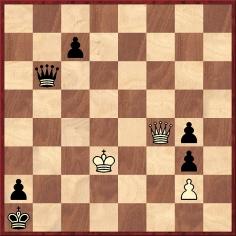
1 Qc1+ Qb1+ 2 Kd2 c6 3 Kd1 c5 4 Kd2 c4
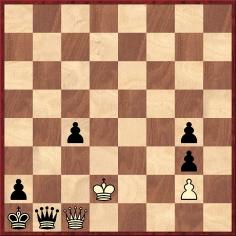
5 Ke2 c3 6 Kd1 c2+ 7 Kd2 Qxc1+ 8 Kxc1 stalemate.
John Nunn (Chertsey, England) points out that the position appears as a study (1923, ‘source unknown’) in the latest van der Heijden study database.
What more can be discovered about the position? At the moment we have only the source specified in C.N. 1050, i.e. page 231 of the August 1924 Wiener Schachzeitung:
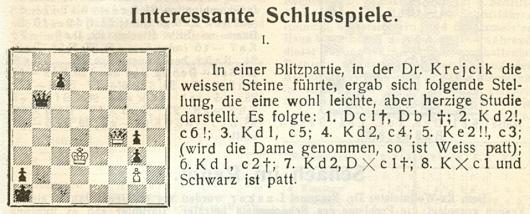
(7172)
A fast game of chess (but what were the exact conditions?) was given on page 168 of the August 1923 Wiener Schachzeitung:
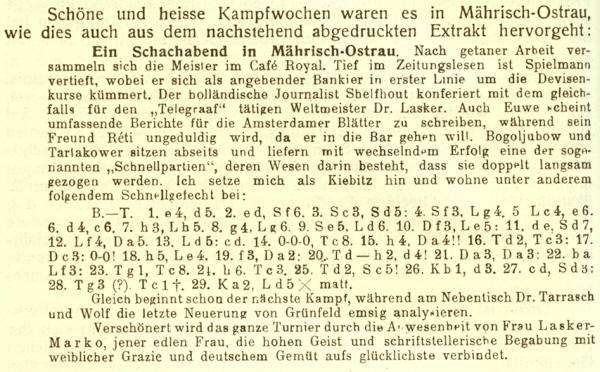
Efim Bogoljubow – Savielly Tartakower
Mährisch-Ostrau, 1923
Center Counter-Game
1 e4 d5 2 exd5 Nf6 3 Nc3 Nxd5 4 Nf3 Bg4 5 Bc4 e6 6 d4 c6 7 h3 Bh5 8 g4 Bg6 9 Ne5 Bd6 10 Qf3 Bxe5 11 dxe5 Nd7 12 Bf4 Qa5 13 Bxd5 cxd5 14 O-O-O Rc8 15 h4
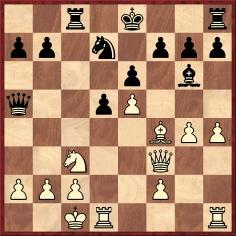
15...Qa4 16 Rd2 Rxc3 17 Qxc3 O-O 18 h5 Be4 19 f3 Qxa2 20 Rdh2 d4 21 Qa3 Qxa3 22 bxa3 Bxf3 23 Rg1 Rc8 24 h6 Rc3 25 Rd2 Nc5 26 Kb1 d3 27 cxd3 Nxd3 28 Rg3 Rc1+ 29 Ka2 Bd5 mate.
(7193)
Kevin Harrison (Hunters Hill, NSW, Australia) asks about the
authenticity of the Danish Gambit miniature H.E. Bird v Emanuel
Lasker, Newcastle-upon-Tyne, 1892: 1 e4 e5 2 d4 exd4 3 c3 dxc3 4
Bc4 cxb2 5 Bxb2 Qg5 6 Nf3 Qxg2 7 Rg1 Bb4+ 8 Ke2 Qh3 9 Bxf7+ Kd8 10
Bxg7 Ne7 11 Ng5 Qh4 12 Ne6 mate.
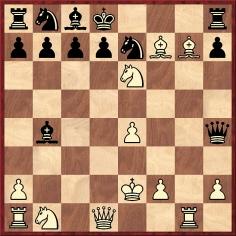
We have no reason to doubt it. The game was published on page 48 of the October 1892 issue of N.T. Miniati’s Chess Review:
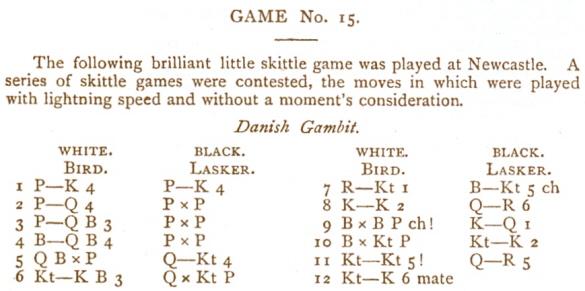
(7326)
A victory by Julius du Mont against Richard Réti at ten seconds a move (London, 1922) was published on page 664 of 500 Master Games of Chess by S. Tartakower and J. du Mont (London, 1952).
‘A typical, sparkling, ten-second contest replete with hair-raising escapes, astonishing sacrifices, counter-sacrifices, furious assaults on both kings and amusing, child-like blunders.’
That was Santasiere’s description of a game which he won in a rapid-transit tournament at the Marshall Chess Club:
Anthony Edward Santasiere – Shedlovsky1 e4 d5 2 exd5 Qxd5 3 Nc3 Qa5 4 b4 Qxb4 5 Rb1 Qd6 6 Nf3 a6 7 Bc4 e6 8 d4 Nf6 9 O-O b5 10 Bd3 Bb7 11 Qe2 c5 12 dxc5 Qxc5 13 Nxb5 axb5 14 Rxb5 Qc7 15 Nd4 Bd6
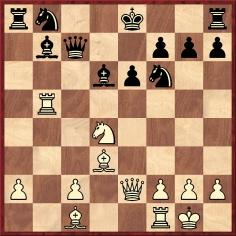
16 Nxe6 fxe6 17 Qxe6+ Kf8 18 Bh6 Bxh2+ 19 Kh1 Bxg2+ 20 Kxg2 Be5 21 Rxe5 Ra6 22 Qf5 Kf7 23 Bxa6 gxh6 24 Bd3 Rg8+ 25 Kh3 Nbd7 26 Re3 Rg5 27 Qf3 Rh5+
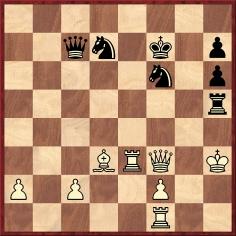
28 Qxh5+ Nxh5 29 Rf3+ Ndf6 30 Bxh7 Nf4+ 31 Kh4 Qe5 32 Rb1 Qh5+ 33 Kg3 Ne4+ 34 Kxf4 Resigns.
The score has been supplied by Eduardo Bauzá Mercére, from page 4A of the Brooklyn Daily Eagle, 23 September 1926:
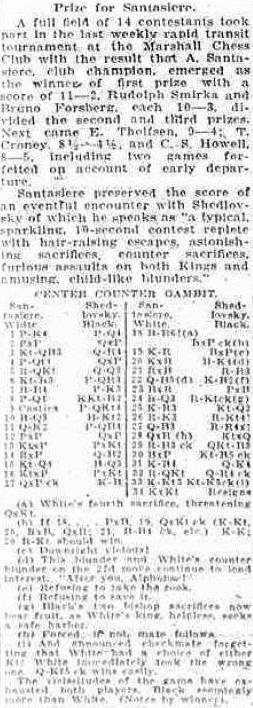
A basic computer-check suggests many improvements to Santasiere’s annotations.
(7487)
Noting the remark by Capablanca cited in C.N. 7557 (‘were it not for the fact that I have beaten Lasker at rapid chess, he would be considered the foremost rapid chessplayer in the world’), Jonathan Berry (Nanaimo, BC, Canada) writes:
‘I regret the passing of the label “Allegro” in reference to games with a time-control of about 30 minutes. It was in minor usage, persisted in Scotland, but eventually disappeared behind what I regard as inferior (either less descriptive or more ambiguous) labels: “Active”, “Action” and “Rapid”.’
(7580)
Old specimens of fast chess are fairly scarce. Below are three from a tournament held at Marshall’s Chess Divan, New York on 28 April 1917. The time-limit was 20 seconds per move, and Marshall won the event with 5½ points, ahead of Janowsky (5), Chajes (4½), Jaffe (4), Bernstein (3), Hodges (3), Black (2½) and Beynon (½).
Dawid Janowsky – Jacob Bernstein1 e4 e5 2 Nf3 Nc6 3 Nc3 Nf6 4 Bb5 Bb4 5 O-O O-O 6 d3 d6 7 Bg5 Bxc3 8 bxc3 Qe7 9 Re1 Nd8 10 d4 Ne6 11 Bc1 Rd8 12 Rb1 c5 13 Bc4 b6 14 d5 Nf8 15 h3 Rb8 16 Bd3 a6 17 c4 Bd7 18 Nh2 Ng6 19 Ng4 Nxg4 20 hxg4 b5 21 g3 bxc4 22 Rxb8 Rxb8 23 Bxc4 Bb5 24 Bd3 Bxd3 25 Qxd3 Qb7 26 Bd2 Qb5 27 Qa3 f6 28 Kg2 Nf8
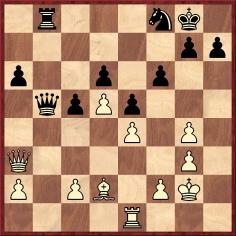
29 g5 Nd7 30 Qf3 fxg5 31 Bxg5 Rf8 32 Qg4 Qb4 33 Re3 Nf6 34 Qe6+ Rf7 35 Bxf6 gxf6 36 Qxd6 a5 37 Qe6 Qc4 38 Qc8+ Rf8 39 Qg4+ Kf7 40 Rb3 Qa6 41 Qd7+ Kg6 42 Rb7 Resigns.
Jacob Bernstein – Frank James Marshall1 d4 d5 2 c4 e6 3 Nc3 c5 4 cxd5 exd5 5 Nf3 Nc6 6 e3 Nf6 7 Be2 Bd6 8 O-O O-O 9 b3 Bg4 10 Bb2 cxd4 11 exd4 Rc8 12 Rc1 Bf4 13 Rb1 Re8 14 h3 Bh5 15 Nh2 Bg6 16 Bd3 Qd6 17 Nf3 Ne4 18 Nb5 Qf6 19 Bxe4 Bxe4 20 Ra1 Bb8 21 Re1 Qf4 22 Ne5 Nxe5 23 dxe5 Qg5 24 f3
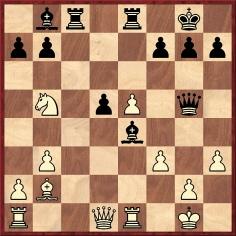
24...Rc2 25 Re2 Rxb2 26 fxe4 Rxe2 27 Qxe2 Qxe5 28 Rd1 a6 29 Nd4 Ba7 30 Qd2 dxe4 31 Kh1 Rd8 32 Nc6 Rxd2 33 Rxd2 Qa1+ 34 White resigns.
Charles Jaffe – Roy Turnbull Black1 d4 Nf6 2 Nf3 c6 3 e3 d6 4 Nc3 Bg4 5 Be2 Nbd7 6 e4 e5 7 O-O Be7 8 Be3 O-O 9 Nh4 Bxe2 10 Qxe2 Nxe4 11 Nxe4 Bxh4 12 Nxd6 exd4 13 Bxd4 Qc7 14 Nf5 Bf6 15 Rad1 Qf4 16 Ne7+ Kh8 17 Be3 Qc7 18 Nf5 Bxb2 19 Qg4 Rad8 20 Rd4 g6 21 Bh6 Bxd4 22 Qxd4+ Qe5
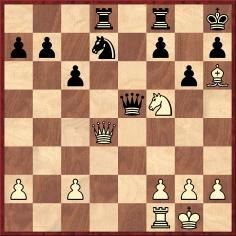
23 Bg7+ Resigns.
Source: American Chess Bulletin, May-June 1917, pages 110-113.
(7624)
The three games were given in the Brooklyn Daily Eagle on page 3 of the 3 May 1917 edition.
Further to the recent material on Ernst Klein, a lightning game on page 219 of the July 1957 Chess Review may be noted:
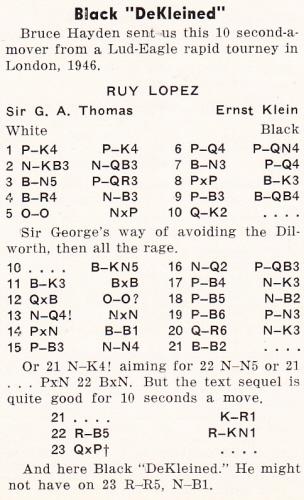
Sir George Thomas – Ernst Ludwig Klein
London, 1946
Ruy López
1 e4 e5 2 Nf3 Nc6 3 Bb5 a6 4 Ba4 Nf6 5 O-O Nxe4 6 d4 b5 7 Bb3 d5 8 dxe5 Be6 9 c3 Bc5 10 Qe2 Bg4 11 Be3 Bxe3 12 Qxe3 O-O 13 Nd4 Nxd4 14 cxd4 Bc8 15 f3 Ng5 16 Nd2 c6 17 f4 Ne6 18 f5 Nc7 19 f6 g6 20 Qh6 Ne6 21 Bc2 Kh8
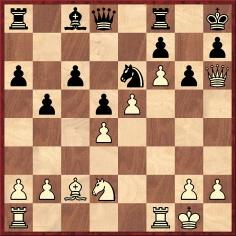
22 Rf5 Rg8 23 Qxh7+ Resigns.
(7732)
Bruce Hayden also supplied the Thomas v Klein miniature to Assiac for publication. See pages 51-52 of Assiac’s book The Delights of Chess (London, 1960), which stated that ‘the game was played at “lightning speed” (in less than ten minutes)’.
(7797)
Dominique Thimognier (Fondettes, France) observes that when the familiar brevity between Léon Monosson and Maurice Fauque in the 1935 Paris championship was published on page 16 of L’Echo des Echecs, November 1935 it was indicated by the winner that the game had lasted five minutes:
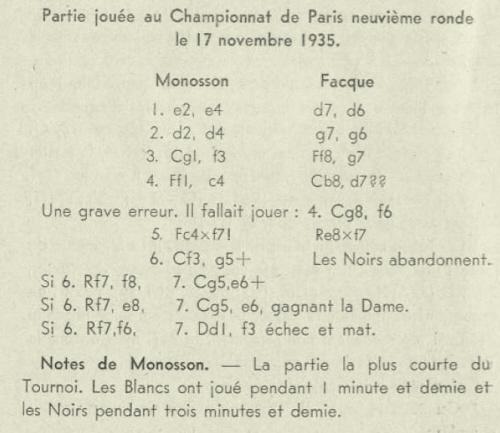
(7921)
The above text is an extract from C.N. 7921.
Ronald Spurgeon (Sutton, England) draws attention to a feature on page 169 of the November 1923 American Chess Bulletin:
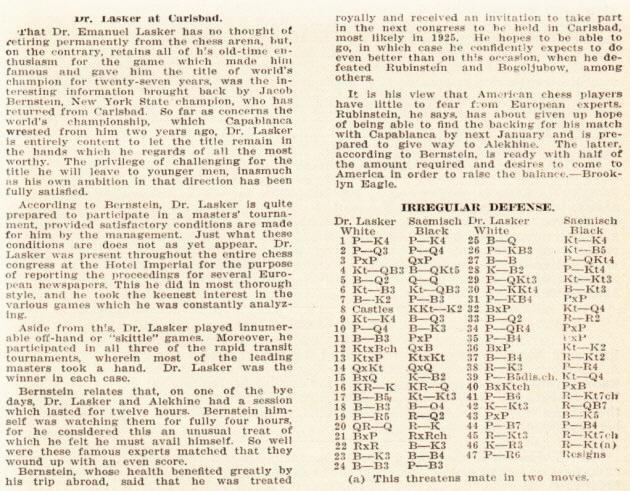
Our correspondent asks whether anything further is known about the rapid transit tournaments and about the Lasker v Sämisch game given by the Bulletin.
We have found the score on page 6A of the Brooklyn Daily Eagle, 21 June 1923:
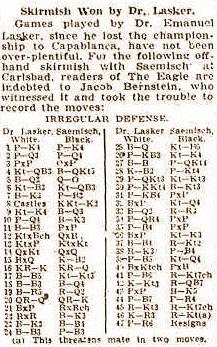
Emanuel Lasker – Friedrich Sämisch
Carlsbad, 1923
King’s Pawn Opening
1 e4 e5 2 d3 d5 3 exd5 Qxd5 4 Nc3 Bb4 5 Bd2 Qd8 6 Nf3 Nc6 7 Be2 f6 8 O-O Nge7 9 Ne4 Bd6 10 d4 Be6 11 Bc3 exd4 12 Nxd6+ Qxd6 13 Nxd4 Nxd4 14 Qxd4 Qxd4 15 Bxd4 Kf7 16 Rfe1 Rhd8 17 Bc5 Ng6 18 Bf3 Bd5 19 Bh5 Rd7 20 Rad1 Re8 21 Bxa7 Rxe1+ 22 Rxe1 Be6 23 Be3 Bf5 24 Bf3 c6 25 Bd1 Ne5 26 f3 Nc4
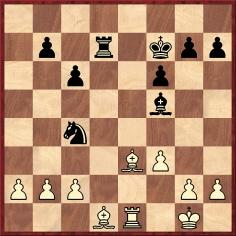
27 Bc1 b5 28 Kf2 g5 29 b3 Nb6 30 g4 Bg6 31 f4 gxf4 32 Bxf4 Nd5 33 Bd2 Ra7
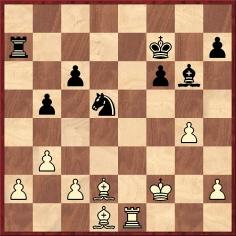
34 a4 bxa4 35 c4 axb3 36 Bxb3 Ne7 37 Bf4 Rb7 38 Re3 h5 39 c5+ Nd5 40 Bxd5+ cxd5 41 c6 Rb2+ 42 Kg3 Rc2 43 gxh5 Be4 44 c7 f5 45 Rb3 Rg2+ 46 Kh3
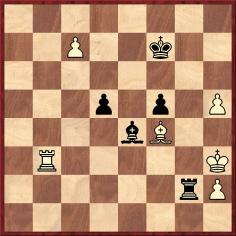
46...Rg8 47 h6 Resigns.
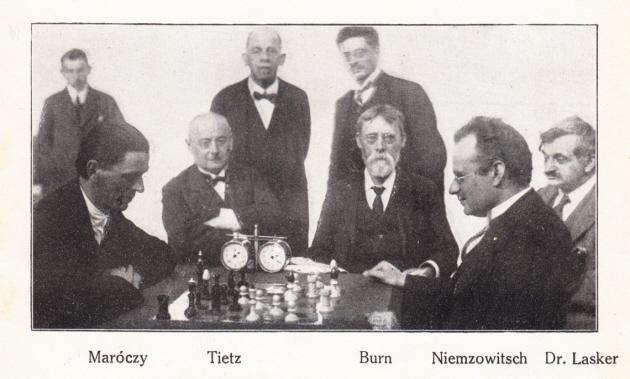
Source: Carlsbad, 1923 tournament book
Regarding rapid transit games in Carlsbad, C.N. 1050 (see page 9 of Chess Explorations) gave the conclusion of Tartakower’s win against Alekhine on 8 May 1923.
(8000)
See also C.N. 2152 above.
On page 627 of Vabanque Dawid Janowsky 1868-1927 by Daniel Ackermann (Ludwigshafen, 2005) the Janowsky v Bernstein was given, with Black misidentified as S.N. Bernstein.
For the game Kostić v Keres, Stockholm, 1937 (blitz tournament), see page 74 of Kings, Commoners and Knaves.
Below is a game contributed by Eduardo Bauzá Mercére. It was played in a rapid transit tournament (ten seconds per move) mentioned on page 182 of the April 1905 American Chess Bulletin.
John Finan Barry – Edward Hymes
New York, 14 April 1905
King’s Pawn Opening
1 e4 d6 2 d4 f5 3 Bd3 fxe4 4 Bxe4 Nf6 5 Bd3 Nc6 6 c3 e5 7 dxe5 Nxe5 8 Bc2 Be7 9 Ne2 O-O 10 O-O Nfg4 11 Bb3+ Kh8 12 h3 Nf6 13 Be3 Bf5 14 Nf4 Qe8 15 Nd2 Bd3 16 Nxd3 Nxd3 17 Qc2 Ne5 18 Rae1 Qh5 19 f4 Ng6 20 Nf3 Nh4 21 Nxh4 Qxh4 22 Bxa7 Nh5 23 Be3 Ng3 24 Rf3 Nf5 25 Bf2 Qh6 26 g4 Nh4 27 Bxh4 Bxh4 28 Ref1 Rae8 29 Qg2 Bd8 30 f5 Qg5 31 Be6 Re7 32 Qe2 Qh4 33 Kg2 h5 34 Rg3 Kh7 35 Qe4 Rf6 36 Qe1 Kh8
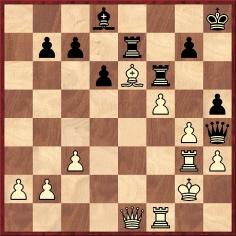
37 g5 Rf8 38 Qe2 Kh7 39 Qe3 Kh8 40 Kh2 Kh7 41 Kg2 Kh8 42 Qd4 Qxd4 43 cxd4 g6 44 d5 gxf5 45 Rgf3 Rg7 46 h4 Be7 47 Rxf5 Rxf5 48 Rxf5 Kh7 49 Kf3 Kg6 50 Rf4 Kh7 51 Ke4 Kh8 52 a4 Kh7 53 b4 Kh8 54 a5 Kh7 55 b5 Kg6
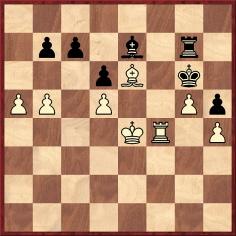
56 a6 bxa6 57 bxa6 Bxg5 58 hxg5 Kxg5 59 a7 Resigns.
Source: Brooklyn Daily Eagle, 28 May 1905, page 9.
(8243)
Eduardo Bauzá Mercére has sent the following from the Brooklyn Daily Eagle, 15 July 1915, page 3:

E. Henry Koehler – Jacob Carl Rosenthal
New York, 1915
Four Knights’ Game
1 e4 e5 2 Nf3 Nc6 3 Nc3 Nf6 4 Bb5 Bb4 5 O-O d6 6 Nd5 Bc5 7 d4 exd4 8 Nxd4 Bd7 9 Nf5 O-O 10 Bg5 Ne5 11 Nxf6+ gxf6 12 Bxd7 fxg5 13 Bb5 Kh8 14 Kh1 g4 15 f4 gxf3 16 gxf3 Qf6 17 f4 Ng6 18 Qh5 Qxb2 19 Rab1 Qxc2 20 Rbe1 c6 21 Rf3 Rg8 22 Qxh7+ Kxh7 23 Rh3+ Nh4 24 Rxh4+ Kg6 25 Rh6 mate.
Since Max Euwe’s name is not often associated with exceptionally fast play, the following passage is noteworthy:
‘He took part in a minor event, and few could suspect that the tall, slender, rosy-cheeked student of 18 would one day be at the top of the chess world. Max Euwe certainly made an impression at Hastings by the ingenuity and rapidity of his play. I remember particularly two games in which he overwhelmed his opponents, with his clock showing an expenditure of only five minutes. That was speed with a vengeance; but he has learned to restrain his youthful impetuosity in his later years of growing mastership.’
Source: Chess and its Stars by Brian Harley (Leeds, 1936), page 41. Harley wrote similarly on page 10 of the Observer, 17 August 1919:
‘The Dutch contingent, numbering seven all told, are very enthusiastic players. The youthful Euwe, who is playing in one of the first-class tournaments, spent just five minutes each on his last two match games, winning both.’
Euwe participated in the First Class, Section C tournament in Hastings, finishing equal fourth. His victory over J.J. O’Hanlon is well known, although it was not included in From My Games 1920-1937 (London, 1938). According to pages 7-8 of Max Euwe by Hans Kmoch (Berlin and Leipzig, 1938) it was played on 14 August 1919, but was it one of the two quickly-won games referred to by Harley?
The earliest game of Euwe’s that we have seen is his victory over Jacques Davidson in a simultaneous exhibition given by the latter in Amsterdam in February 1912. The score was published in C.N. 1811 from the above-mentioned book by Kmoch; see page 80 of Chess Explorations.
(8491)
Dan Scoones (Port Coquitlam, BC, Canada) forwards a neglected game for which each player had only five minutes:
Mikhail Tal – Boris Spassky
Rapid championship of Moscow, 1957
Ruy López
1 e4 e5 2 Nf3 Nc6 3 Bb5 f5 4 Nc3 Nd4 5 exf5 Nf6 6 Nxe5 Bc5 7
O-O O-O 8 Nf3 c6 9 Nxd4 Bxd4 10 Ne2 Be5 11 Bc4+ d5 12 Bd3 c5 13
Ng3 c4 14 Be2 Bxg3 15 hxg3 Bxf5 16 d3 b5 17 a4 a6 18 axb5 axb5
19 Rxa8 Qxa8 20 dxc4 dxc4 21 Bf3
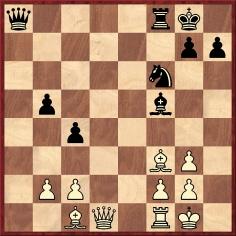
21...Qa2 22 Re1 Qb1 23 Qd6 Qxc2 24 Bd5+ Nxd5 25 Qxd5+ Kh8
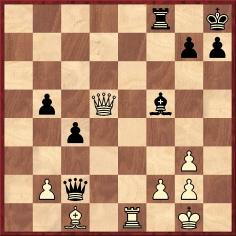
26 Qf7 Rg8 27 Bh6 and White won.
Source: Chess Life, February 1963, page 38.
The game appeared in an article by Eliot Hearst which reported that the moves had been recorded by B. Weinstein. It was also noted that the same opening had occurred in the game between Tal and Spassky in the USSR championship earlier in 1957.
At move 15 Hearst commented: ‘For the last five moves the two players had consumed two minutes, a considerable time; for the next six moves they used some ten seconds only.’ Spassky spent some time on 21...Qa2, and ‘Tal also thought a while on his reply and prepared a pretty and decisive trap’.
(8513)
On pages 52-53 of the 1/2014 New in Chess Nigel Short writes about rapid chess (defined in the article as games with ‘approximately half an hour per player’). The final paragraph:
‘In recent years, publishers have commissioned biographies of ever-more obscure, peripheral chess figures. I have read the weighty McFarland hardback of Albert Beauregard Hodges from beginning to end and I still can’t tell you anything about him. Quite possibly this is because I am a philistine, or an amnesiac, but the alternative explanation is that Hodges’ life is not an inherently interesting subject. Far better would be for some proper researcher to examine the enormous wealth of material on rapid chess and write its definitive history. With luck, this briefest of sketches may serve as a catalyst.’
A book on such a topic (ideally, on all forms of fast chess) could certainly be an excellent addition to the thematic chess books of McFarland & Company, Inc., which include Blindfold Chess by E. Hearst and J. Knott (2009) and, alas, Women in Chess by J. Graham (1987), although not much else. Chess prodigies is another subject which would lend itself to the McFarland treatment.
(8530)
Game 93 in One Hundred and Seventy Five Chess Brilliancies by P. Wenman (London, 1947) is a ten-move victory by the author (Bristol, 1939) played at ten seconds per move in which he gave the odds of his queen’s rook and queen’s knight.
From page 285 of Chess World, 1 December 1948, in a column written by M.E. Goldstein:
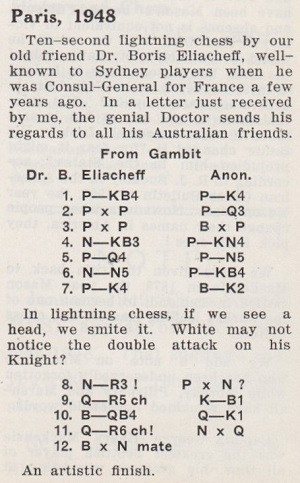
1 f4 e5 2 fxe5 d6 3 exd6 Bxd6 4 Nf3 g5 5 d4 g4 6 Ng5 f5 7 e4 Be7 8 Nh3 gxh3 9 Qh5+ Kf8 10 Bc4 Qe8 11 Qh6+ Nxh6 12 Bxh6 mate.
On page 62 of Irving Chernev’s 1000 Best Short Games of Chess (New York, 1955) White was identified as ‘Eliascheff’.
(9270)
Steve Wrinn (Homer, NY, USA) draws attention to a passage on page 404 of Garry Kasparov on Garry Kasparov Part III: 1993-2005 (London, 2014) regarding the game Leko v Kasparov, Linares, 2003:
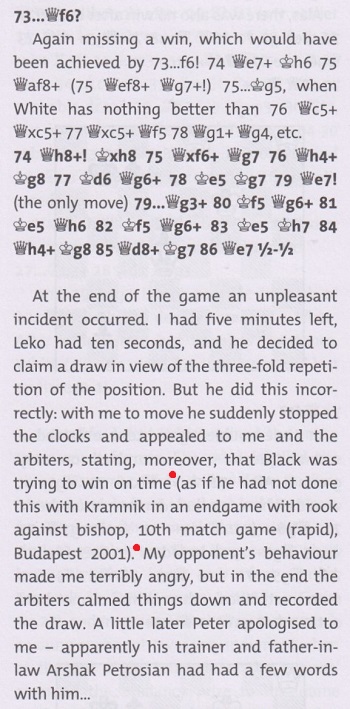
Our correspondent remarks:
‘In the rapid game referred to by Kasparov it was Kramnik who had the rook against Leko’s bishop. Kramnik ultimately won on time at the 133rd move, and his decision to play on in a theoretically drawn position elicited various comments. For example, in the Los Angeles Times, 14 January 2001 Jack Peters wrote:
“The players revealed opposing attitudes to rapid chess in the time scrambles at the end of the seventh and tenth games. In both cases, Kramnik had a nominal advantage that Leko neutralized easily. In the seventh game, Kramnik, with only five seconds remaining, offered a draw to Leko, who had 23 seconds left. Leko graciously accepted. In the tenth game, Kramnik had the edge on the clock and kept playing a drawn position until Leko ran out of time.”’
(9273)
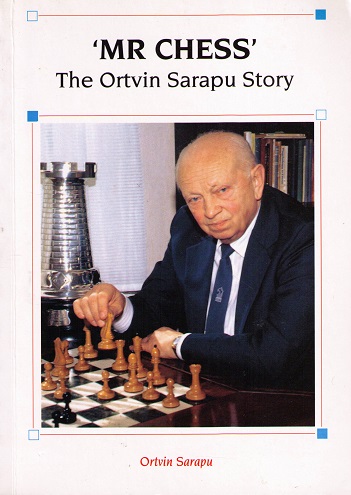
From Calle Erlandsson (Lund, Sweden):
‘Page 4 of ‘Mr Chess’ The Ortvin Sarapu Story by Ortvin Sarapu (Wainuiomata, 1993) states that he “won the Copenhagen championship and the five-minute lightning championship in 1946”.
I have not found a note about the lightning tournament, but it is clear that Jens Enevoldsen won the Copenhagen championship in 1946. The crosstable was given on page 124 of the August 1946 issue of Skakbladet:’
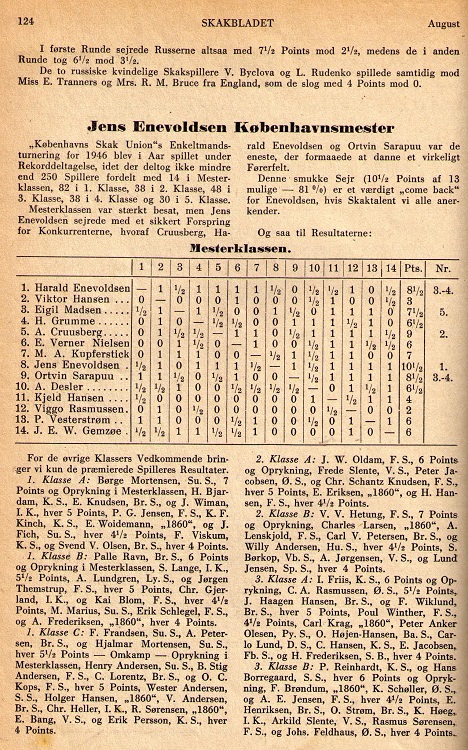
(9477)
See also C.N.s 11063 and 11308.
‘Chess is the most creative, fascinating and challenging game there is; and the most exciting spine-tingling form of chess is Blitz.’
Source: Walter Browne on page 1 of the first issue (May-June 1988) of his magazine Blitz Chess.
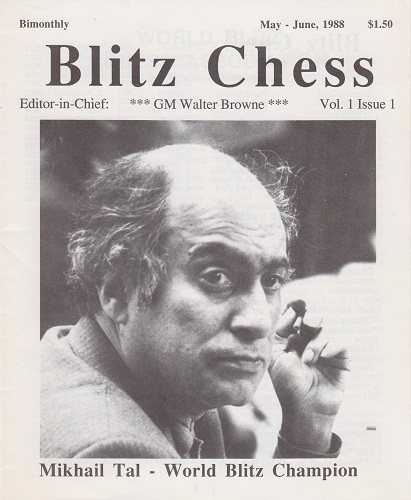
(9969)
A game submitted by Eduardo Bauzá Mercére (New York, NY, USA):
Hermann Helms – Louis Persinger
Played at ten seconds per move (exact venue and date?)
Petroff Defence
1 e4 e5 2 Nf3 Nf6 3 Nxe5 d6 4 Nf3 Nxe4 5 d4 d5 6 Bd3 f5 7 c4 c6 8 cxd5 cxd5 9 Nc3 Nc6 10 O-O Be7 11 Qe2 Nxc3 12 bxc3 O-O 13 Bf4 Re8 14 Rfe1 Bd7 15 Rab1 b6 16 Qc2 g6 17 Qb3 Bf6 18 Qxd5+ Kg7 19 Bc4 Rxe1+ 20 Rxe1 Rc8 21 Qf7+ Kh8
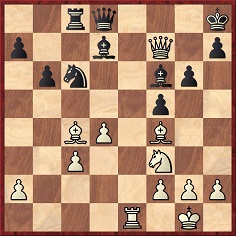
22 Re8+ Resigns.
Source: New York Post: 7 December 1942, page 50.
(10607)
From pages 306-307 of The Delights of Chess by Assiac (New York, 1974):
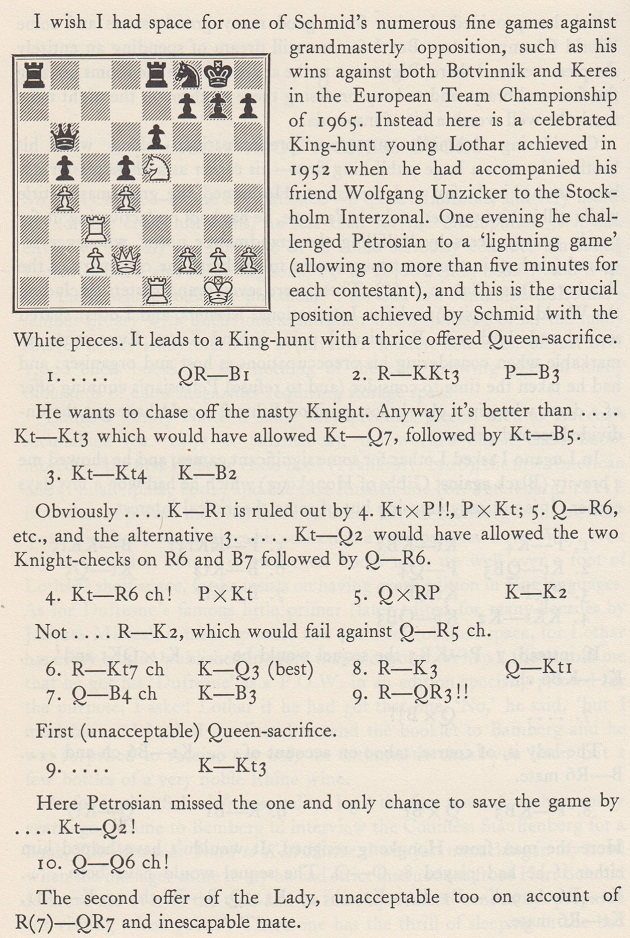

Assiac had also presented the conclusion on page 202 of Chess Treasury of the Air by Terence Tiller (Harmondsworth, 1966):
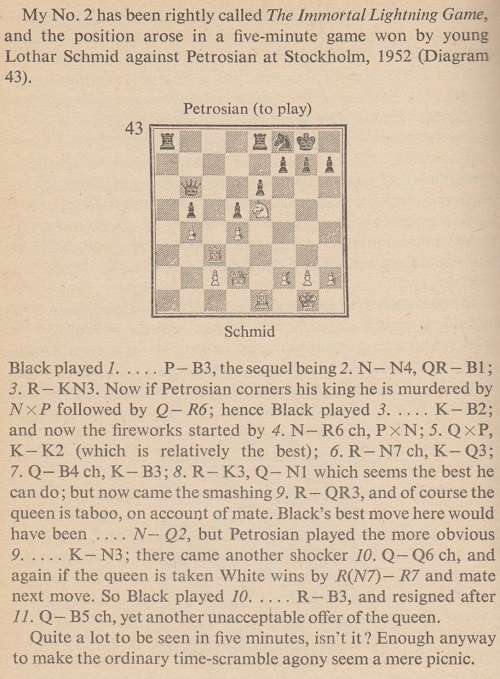
1 e4 c6 2 Nc3 d6 3 d4 Nf6 4 Bf4 Qb6 5 Qd2 Nbd7 6 Nf3 e6 7 Bd3 Be7 8 O-O O-O 9 a4 Qc7 10 e5 Nd5 11 Nxd5 cxd5 12 Rae1 Re8 13 Re3 Nf8 14 Rfe1 Bd7 15 a5 a6 16 exd6 Bxd6 17 Bxd6 Qxd6 18 Ne5 Bb5 19 Bxb5 axb5 20 b4 b6 21 axb6 Qxb6 22 Rc3 f6 23 Ng4 Rac8 24 Rg3 Kf7 25 Nh6+ gxh6 26 Qxh6 Ke7 27 Rg7+ Kd6 28 Qf4+ Kc6 29 Re3 Qb8 30 Ra3 Kb6 31 Qd6+ Rc6 32 Qc5+ Resigns.
The full score of this allegedly ‘celebrated’ game is in databases, but which is the earliest, or best, primary source?
(11178)
Hans-Georg Kleinhenz (Munich, Germany) sends a report by Lothar Schmid on pages 382-383 of Caissa (‘2. Oktober-Heft 1952’):
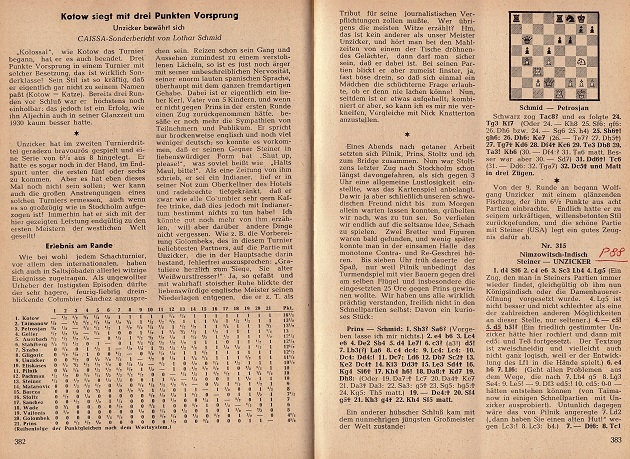
(11182)
Yandy Rojas Barrios (Cárdenas, Cuba) raises the topic of the 1906 rapid transit tournament at the Manhattan Chess Club, New York referred to by Capablanca towards the end of Chapter II (page numbers vary) of My Chess Career (London, 1920):
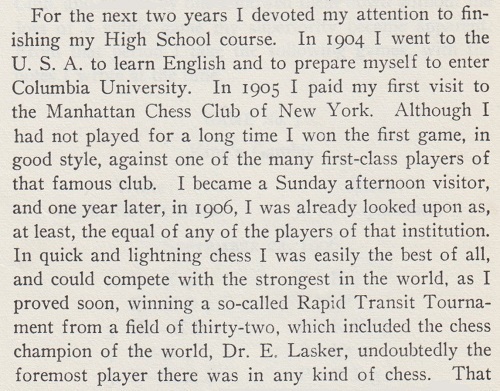
A reference to the tournament on page 35 of the February 1907 American Chess Bulletin was shown in C.N. 10421:

From page 8 of the Chicago Tribune, 20 January 1907:

On page 100 of The Unknown Capablanca by David Hooper and Dale Brandreth (London, 1975) the semi-final pairings against Davidson and Delmar were given the other way round:
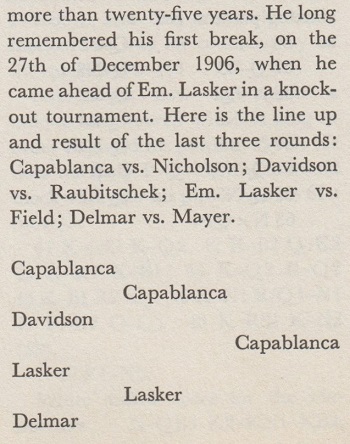
A later report on page 5 of the New York Evening Post, 23 January 1907:
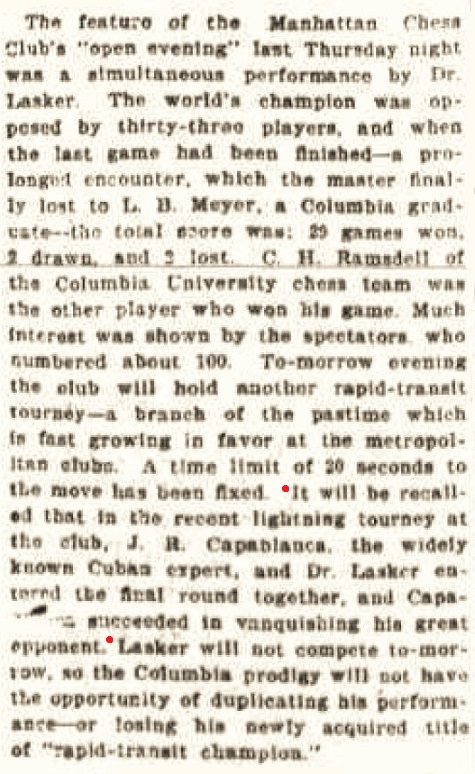
No earlier item in the Evening Post specifically on the December 1906 tournament has yet been found.
An assessment of Lasker and Capablanca was provided by Walter Penn Shipley on page 9 of the Philadelphia Inquirer, 20 January 1907:
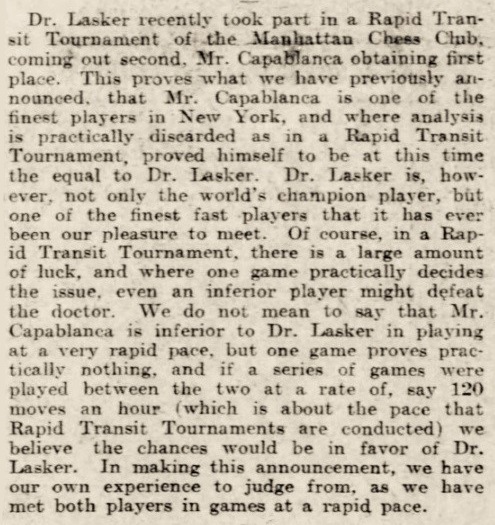
Mr Rojas Barrios notes that in secondary sources the tournament which brought together Lasker and Capablanca in December 1906 is sometimes misdated April 1906, one example being page 28 of El ajedrez en Cuba by José Luis Barreras Meriño (Havana, 2002):
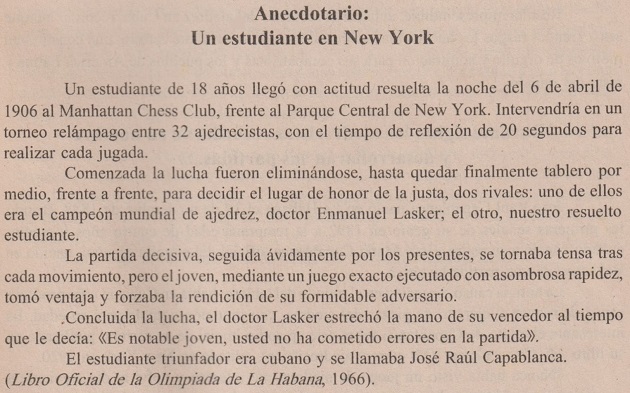
The source indicated (page 11 of the book on the Havana, 1966 Olympiad) had given no date for the rapid transit tournament:
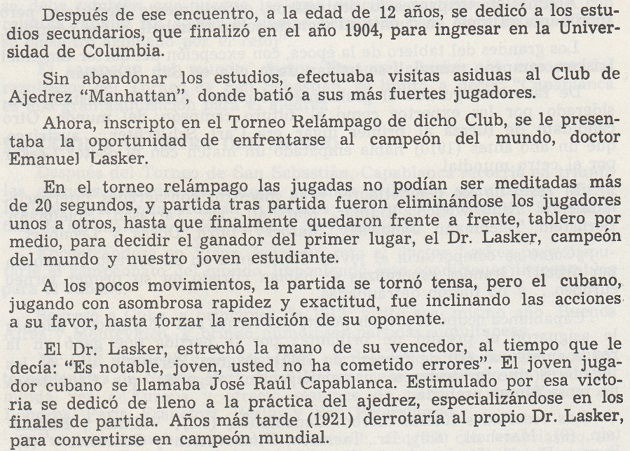
As our correspondent also points out, the April 1906 event was at the Rice Chess Club. From pages 61-63 of the April 1906 American Chess Bulletin:
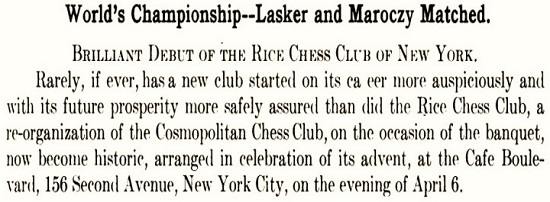

See too page 309 of our book on Capablanca.
C.N. 6077 noted that the remark by Lasker about Capablanca’s freedom from error, mentioned in the two Cuban books above, was supposedly made after their ten-game rapid transit match in Berlin in 1914.(11397)
Page 167 of All About Chess by Al Horowitz (New York, 1971) has a game that we have not seen in databases:
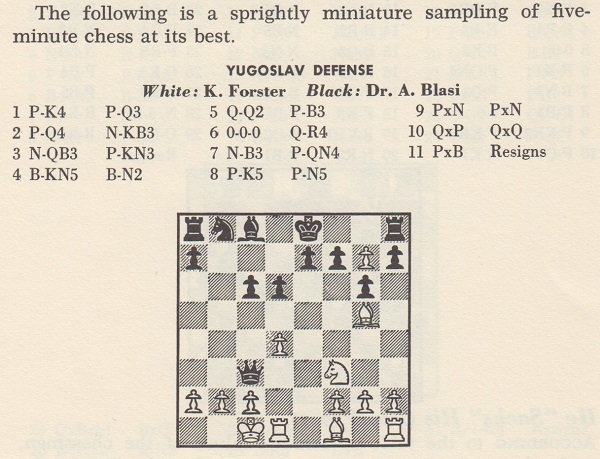
1 e4 d6 2 d4 Nf6 3 Nc3 g6 4 Bg5 Bg7 5 Qd2 c6 6 O-O-O Qa5 7 Nf3 b5 8 e5 b4 9 exf6 bxc3 10 Qxc3
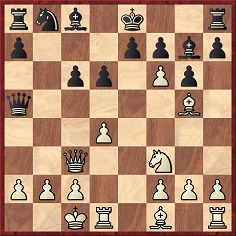
10...Qxc3 11 fxg7 Resigns.
Eduardo Bauzá Mercére points out Horowitz’s article was originally published in the Saturday Review of the New York Times, 14 February 1969, page 14. The date and venue of the game have not been found.
Our correspondent adds two other specimens of fast chess:
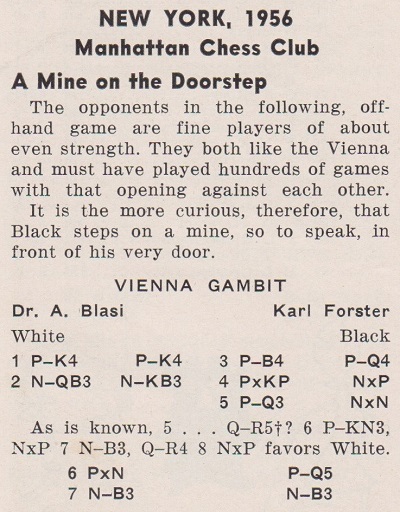
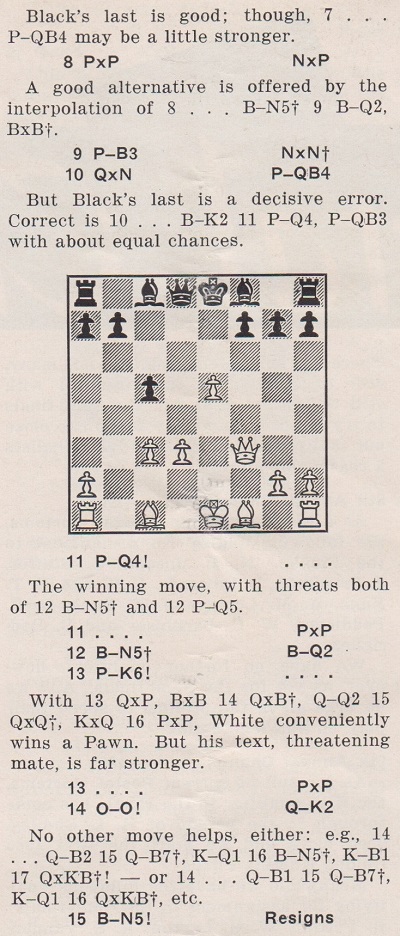
Chess Review, October 1956, page 315
1 e4 e5 2 Nc3 Nf6 3 f4 d5 4 fxe5 Nxe4 5 d3 Nxc3 6 bxc3 d4 7 Nf3 Nc6 8 cxd4 Nxd4 9 c3 Nxf3+ 10 Qxf3 c5 11 d4 cxd4 12 Bb5+ Bd7
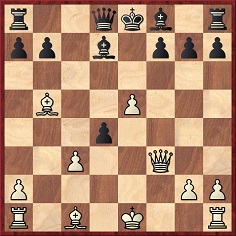
13 e6 fxe6 14 O-O Qe7 15 Bg5 Resigns.
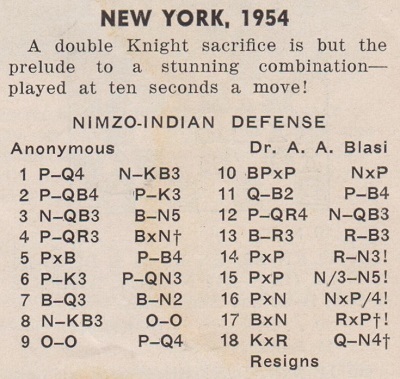
Chess Review, May 1954, page 129
1 d4 Nf6 2 c4 e6 3 Nc3 Bb4 4 a3 Bxc3+ 5 bxc3 c5 6 e3 b6 7 Bd3 Bb7 8 Nf3 O-O 9 O-O d5 10 cxd5 Nxd5 11 Qc2 f5 12 a4 Nc6 13 Ba3 Rf6 14 dxc5 Rg6 15 cxb6
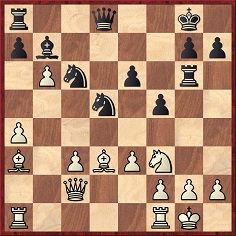
15...Ncb4 16 cxb4 Nxb4 17 Bxb4 Rxg2+ 18 Kxg2 Qg5+ 19 White resigns.
Mr Bauzá Mercére notes too the reference to ‘Dr Anthony Blasi of New York’ on page 218 of the July 1954 Chess Review.
(11417)
Eduardo Bauzá Mercére sends a game on page 42 of the Ottawa Journal, 24 July 1976:
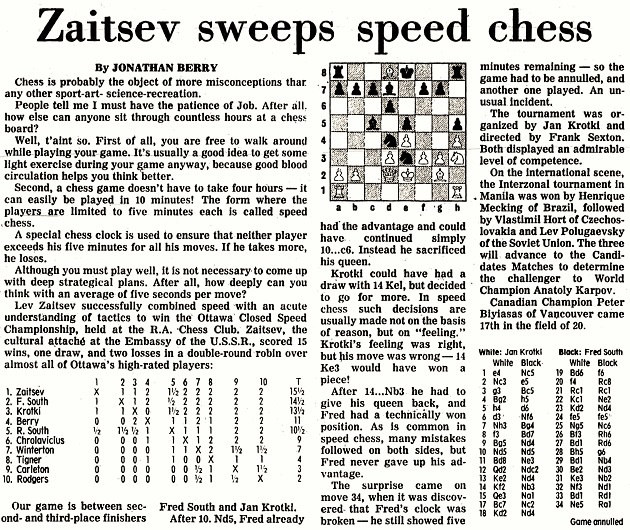
We are grateful to Jonathan Berry for permission to reproduce his column.
1 e4 Nc6 2 Nc3 e5 3 g3 Bc5 4 Bg2 h5 5 h4 d6 6 d3 Nf6 7 Nh3 Bg4 8 f3 Bd7 9 Bg5 Nd4 10 Nd5
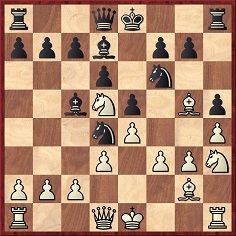
10...Nxd5 11 Bxd8 Ne3 12 Qd2 Ndxc2+ 13 Ke2 Nd4+ 14 Kf2 Nb3 15 Qxe3 Bxe3+ 16 Kxe3 Nxa1 17 Bxc7 Nc2+ 18 Kd2 Nd4 19 Bxd6 f6 20 f4 Rc8 21 Rc1 Rxc1 22 Kxc1 Ne2+ 23 Kd2 Nd4 24 fxe5 fxe5 25 Ng5 Nc6 26 Bf3 Rh6 27 Bd1 Rxd6 28 Bxh5+ g6 29 Bd1 Nb4 30 Be2 Nxd3 31 Ke3 Nxb2 32 Nf3 Nd1+ 33 Bxd1 Rxd1 34 Nxe5 Ra1. Game annulled.
(11523)
There are few photographs of fast chess events of times past, but a shot is given here from page 38 of The Book of the Pan-American Chess Tournament 1926 edited by Hermann Helms (New York, 1926):
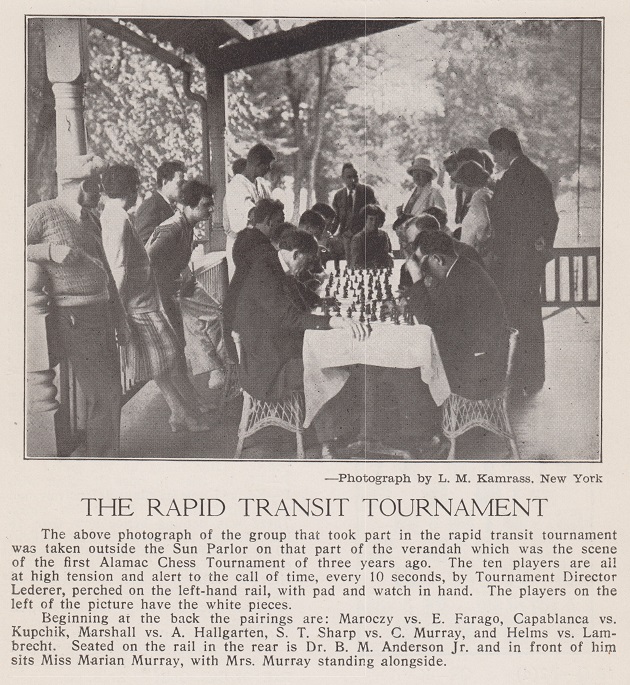
The picture is also on page 91 of the American Chess Bulletin, July-August 1926.
(11555)
A report on the 1943 Metropolitan Speed Championship on pages 282-283 of the October 1943 Chess Review:
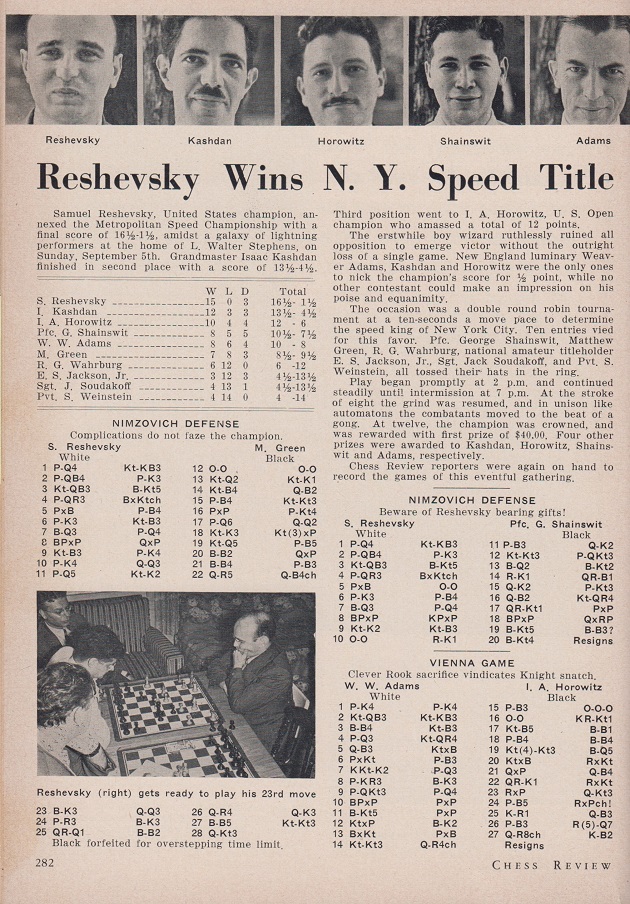
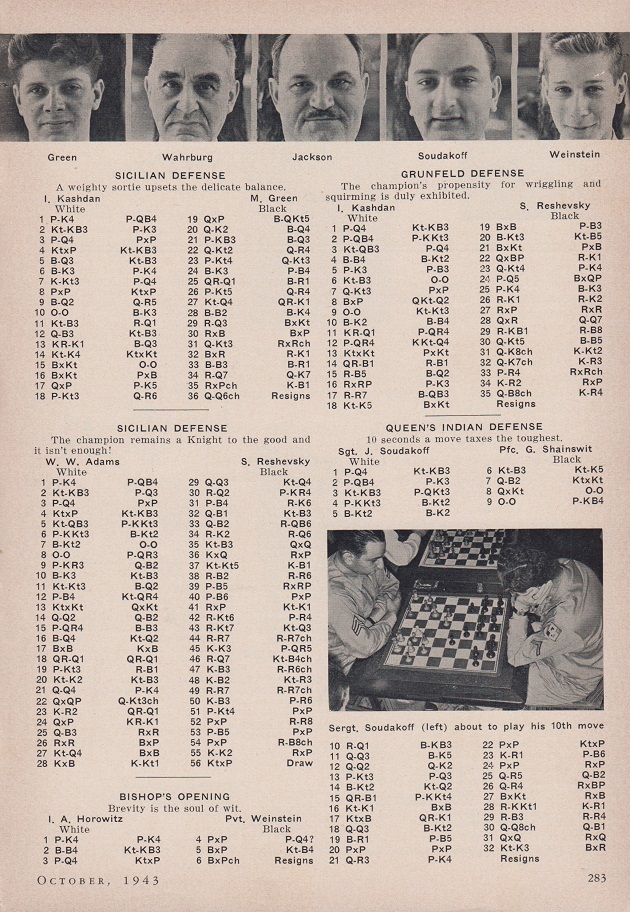
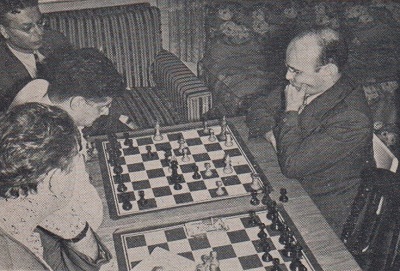
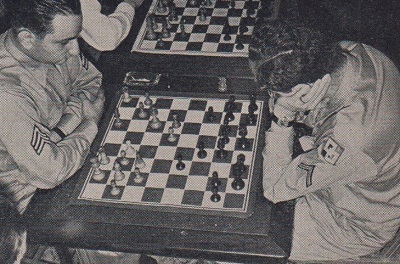
Eduardo Bauzá Mercére forwards an Infobae report which mentions an exploit by Horacio Tomás Amil Meilán in his mid-90s: in 2018 he won a five-minute tournament at the Club Argentino de Ajedrez, Buenos Aires.
A victory by Joseph Platz over Hermann Helms (New York, 1943) at five seconds per move was published on page 43 of Chess Memoirs by J. Platz (Coraopolis, 1979).
From page 291 of the Chess Player’s Chronicle, 16 December 1891:
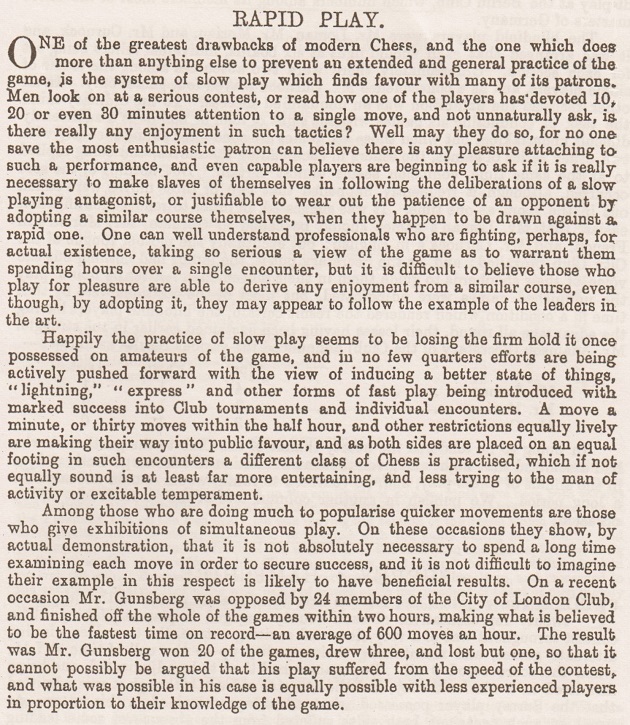
(11798)
From our feature article Kasparov
and his Predecessors, concerning the first Predecessors
volume:
With this carefree approach to the public record, the book frequently creates its own confusion. Page 239, for instance, has Alekhine’s well-known tribute to Capablanca (from pages 105-106 of the April 1956 BCM, although that is naturally not specified) in which he wrote as follows regarding the Cuban’s prowess in 1914: ‘Enough to say that he gave all the St Petersburg masters the odds of 5-1 in quick games – and won!’ In Kasparov’s book the quotation comes in an alternative version: ‘In blitz games he gave all the St Petersburg players odds of five minutes [emphasis added here] to one – and he won’. Why? Since no source of any kind is given, it is impossible for the reader to know.
To the Chess Notes main page.
To the Archives for other feature articles.
Copyright: Edward Winter. All rights reserved.